Herding dogs have a natural instinct to herd and control movement. Humans have used dogs to herd since the beginning of our relationship 10,000 years ago, so there are many breeds. What they all have in common is a need for exercise and training, but they make excellent companion pets and form strong bonds with their families. Herding dogs are excellent with children, often shepherding them on walks and watching over them. The American Kennel Club used to class herding dogs in the working group, but since 1983, they’ve had a herding category of their own.
Let’s take a look at sheep dog breeds, that is, different dogs used for herding.
1. Australian Cattle Dog
Australian cattle dogs are a tough breed capable of herding different types of cattle in the harsh Australian climate. They are clever, long-lived, agile dogs with incredible stamina.
This herding dog is medium-sized, with a short coat, a pointed nose, and large pointed ears. There are two main colors: black, called “blue” or red hair in a white coat.
Cattle dogs’ breed history is murky, but experts think they were developed from the many breeds that were taken by Australian settlers with the addition of the dingo, a native Australian wild dog.
Some experts suggest their good health and long life span is due to their varied breed background.
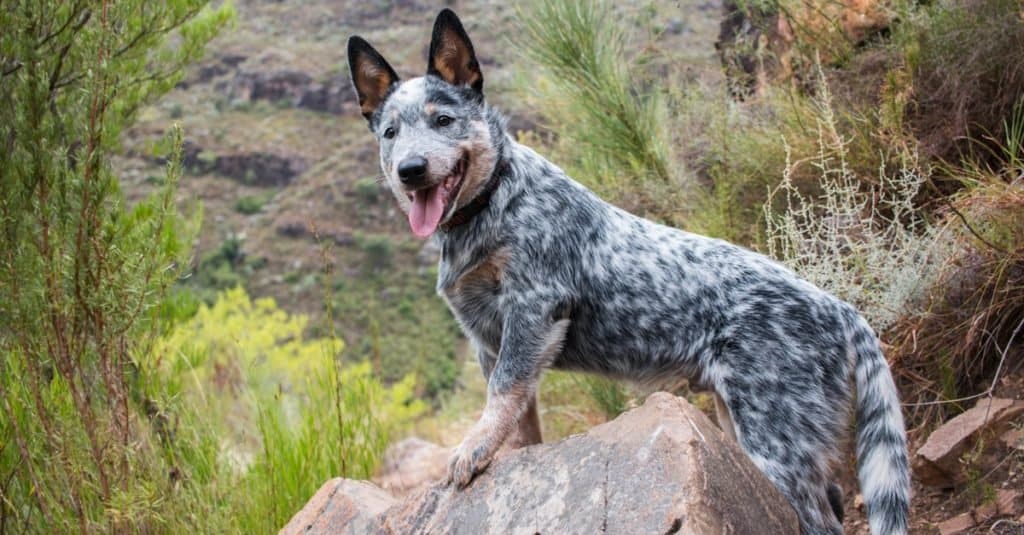
Australian cattle dogs are agile, intelligent, herding dogs with impressive stamina.
©Madelein Wolfaardt/Shutterstock.com
2. Border Collie
Border collies are commonly used in the UK to herd sheep.
The breed was developed in the UK during the 1800s to enhance intelligence and stamina on top of the natural herding instinct. The name most likely evolved from the Celtic word collie, which means “useful.”
Border collies are medium-sized, usually black and white, although other color combinations occur, with a medium double coat that is either short and silky or feels rough and curly.
They are fast sprinters and keen-eyed with sharp hearing. Many experts believe border collies are one of the most intelligent dog breeds. They need a lot of mental and physical stimulation when they are kept as pets.

Border collies are highly intelligent dogs that require considerable mental and physical stimulation.
©studio hoto/Shutterstock.com
3. German Shepherd
We are more used to seeing German shepherd dogs doing police work rather than herding sheep, but their original purpose was herding sheep on German farms.
German shepherds (also called Alsatians in the UK due to negative associations with World Wars 1 and 2) are medium to large-sized dogs that are generally tan with black flanks, faces, ears, pointed noses ears, and fluffy tails.
They can reach speeds of 30 mph and have incredible stamina. They show a great deal of loyalty to their owners but are often stand-offish with strangers. These beautiful dogs are one of the most prolific for coat shedding and need brushing at least twice a week.
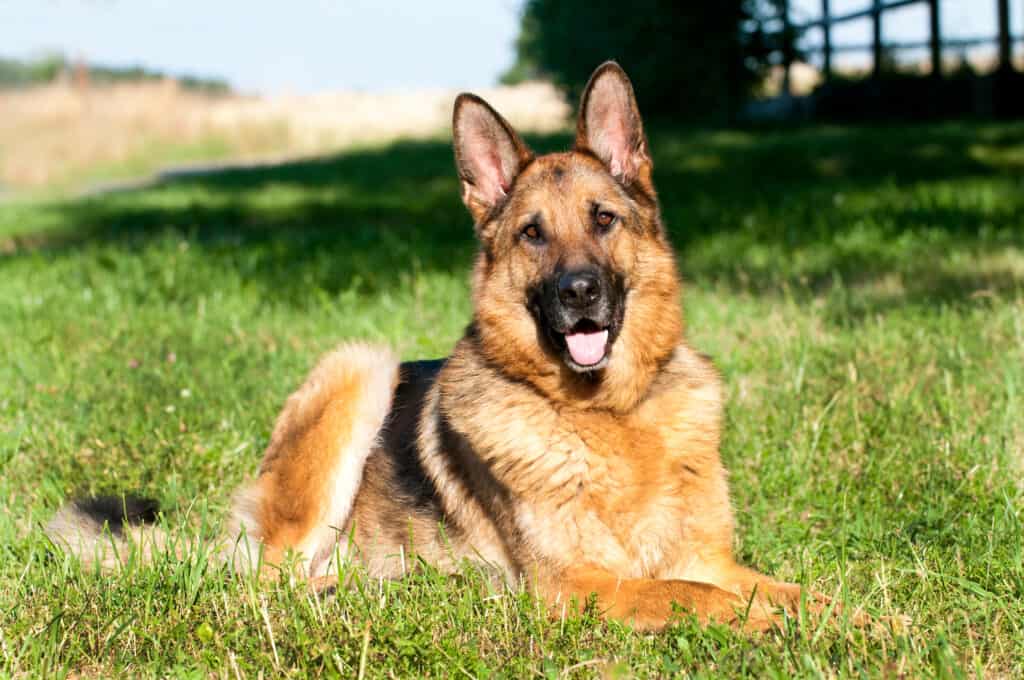
German shepherds can reach speeds of 30 mph and have incredible stamina.
©Dora Zett/Shutterstock.com
4. Icelandic Sheepdog
Icelandic sheepdogs are Iceland’s only native breed. Researchers believe they were brought to Iceland by Vikings over 1000 years ago.
As well as a waterproof double thick coat in black and white, gray, or brown, these intelligent dogs are energic with the stamina needed to herd sheep all day in difficult weather conditions. They are small to medium-sized and known for their friendly, sweet nature. Due to this gentle temperament, they make good family pets but need lots of exercise to employ that natural herding instinct.

Icelandic sheepdogs have the energy to herd sheep all day under extreme conditions.
©Bildagentur Zoonar GmbH/Shutterstock.com
5. Shetland Sheepdog
Native to Scotland’s Shetland Islands, these intelligent herding dogs are known for their eagerness to please and their playful nature. This makes them highly trainable in all types of activity besides herding, such as agility, and they also make excellent jogging partners.
Shetland sheepdogs are a small to medium-sized breed, closely related to border collies, but much shorter, standing 16-18 inches at the shoulder. Their coats are long, straight, and rough enough to keep them warm and dry during rainstorms and strong winds. Best known as shelties, their herding instinct, and protective nature is very strong. Despite their small stature, they need lots of exercise and mental stimulation.
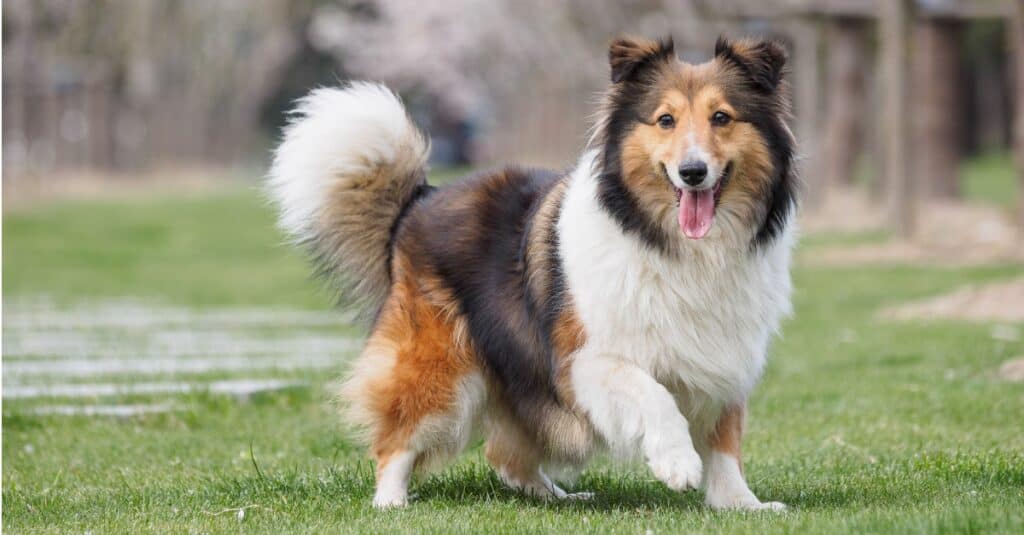
The Shetland sheepdog is more commonly known as a sheltie.
©iStock.com/yanjf
6. Briard
Briards are large herding dogs that can weigh up to 75 pounds. They were initially bred in Brie, France, in the 1400s to guard and herd sheep. They are instantly recognizable with a waxy gray, tan, or black coat and a center parting of fur on their foreheads. Briards have beads, mustaches, and fluffy eyebrows that create a constantly questioning look but are bred to keep off the elements.
They are rugged dogs with vast amounts of stamina on their long, muscular legs. Their incredibly strong herding instinct and protective traits make them great family dogs, but like all herders, they need lots of exercise and mental stimulation, or they can get destructive.
Briards have a real zest for life and are known to be happy-go-lucky dogs with a sweet nature despite their huge size.

Briards weigh up to 75 pounds and have a waxy coat with a center part of fur on their foreheads.
©iStock.com/Aleksandr Zotov
7. Australian Kelpie
Kelpies are dangerous shape-shifting water creatures from Scottish mythology, but there’s nothing mythological about Australian kelpie dogs. They were bred as herding dogs in Australia and, like cattle dogs, are what some folk call “unshowy” with their smooth but tough black or grey outer coat, pointed ears, and pointed nose.
Their coats are short, and they are on the smaller side of medium. Kelpies herd all farm animals, from sheep to chickens! Their signature move is jumping on the backs of sheep in order to cross the herd and drive them from the other side.
Australia Kelpies are the descendants of English collies that traveled to Australia in 1870. They bred with a local dog called Kelpie, and that’s how the breed was established! All Australian kelpie dogs are related to the original Kelpie.
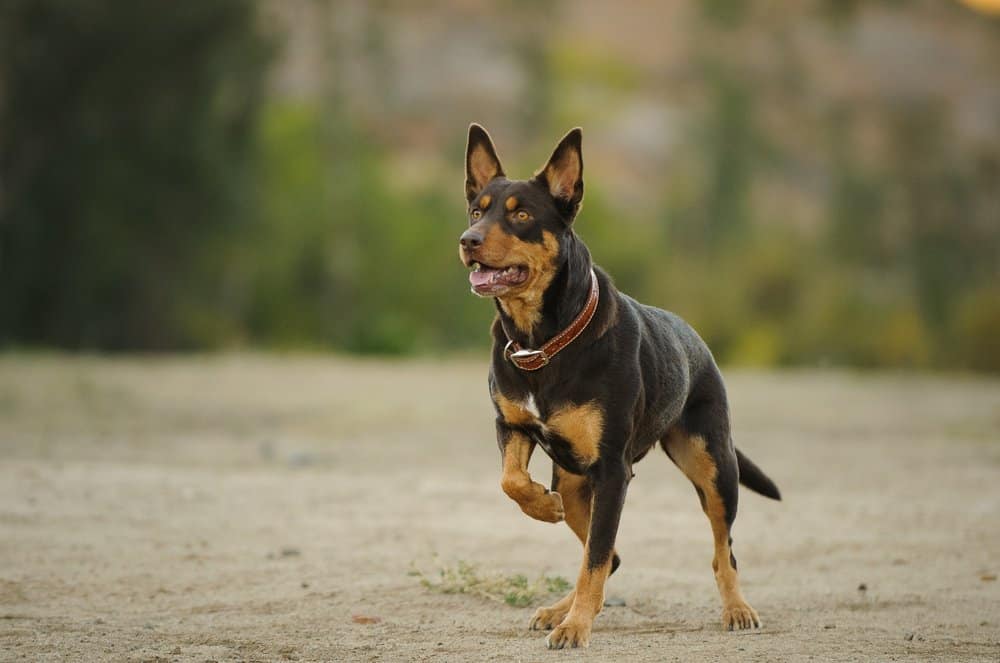
Australian kelpies herd all farm animals, from sheep to chickens.
©everydoghasastory/Shutterstock.com
8. Welsh Corgi
Who would have thought short-legged corgi dogs were originally bred for sheep herding? This small breed is famous for its connection to Queen Elizabeth II, and its name comes from the Welsh word cor for “dwarf” and ci for “dog.” Two breeds reach approximately 12 inches on the shoulder. The Pembroke Welsh corgi is slightly smaller than the Cardigan Welsh.
Corgis are herding sheep dogs bred in Wales to nip the heels of cattle to move them on. They have strong muscular legs and deep, broad chests, and despite their little legs, are capable of running for miles. Short stature does not affect their big dog bark and fearless nature.
Corgi are real character dogs that get impatient with quiet days. They like to run, investigate, and, of course, her family members along. They are excellent pets and amusing companions.
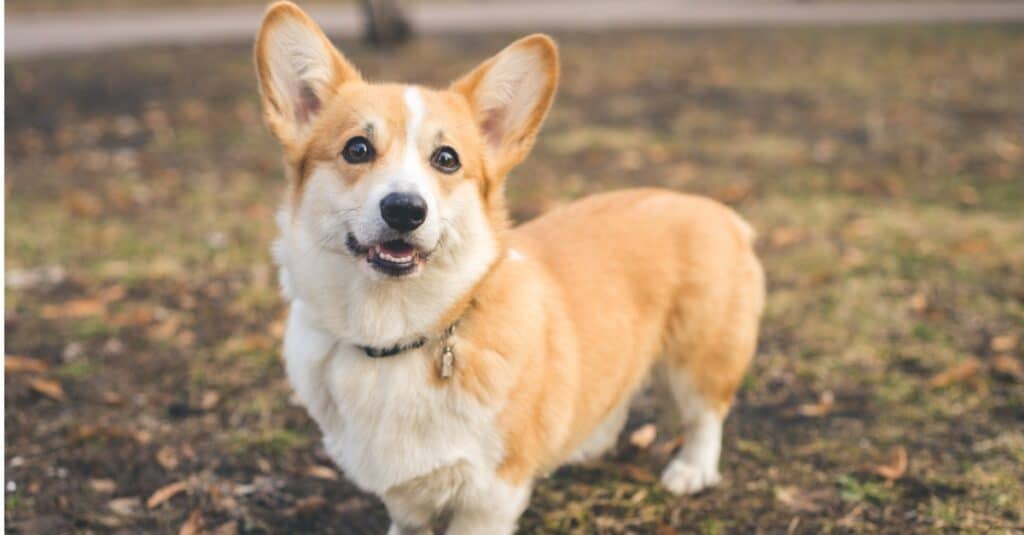
Corgis are herding sheep dogs bred in Wales to nip the heels of cattle to move them on.
©iStock.com/gorodisskij
9. Giant Schnauzer
From one of the smallest herding dogs to arguably the largest!
Giant schnauzers are the largest of three schnauzer breeds. They weigh up to 77 pounds and stand 27.5 inches tall at the shoulder.
This big herding dog can be traced all the way back to Germany’s 16th century, where they were bred to herd cattle and sheep and protect households. This history means giant schnauzers are intelligent dogs with herding instincts but also a strong protective streak. They are good family pets but require lots of training and physical activity.
A word of warning here — if you want to take a giant schnauzer out as your running companion, you’ll struggle to keep up! These dogs have vast leg strides, and their stamina is second to none.
Giant schnauzers are an unmistakable-looking breed with long mustaches and whiskers that give it the name schnauzer (which is German for “snout” or “moustache”). Their coats are chiefly long, black or black and silver. The length and thickness were specifically bred to protect them from weather and bites from rodents.
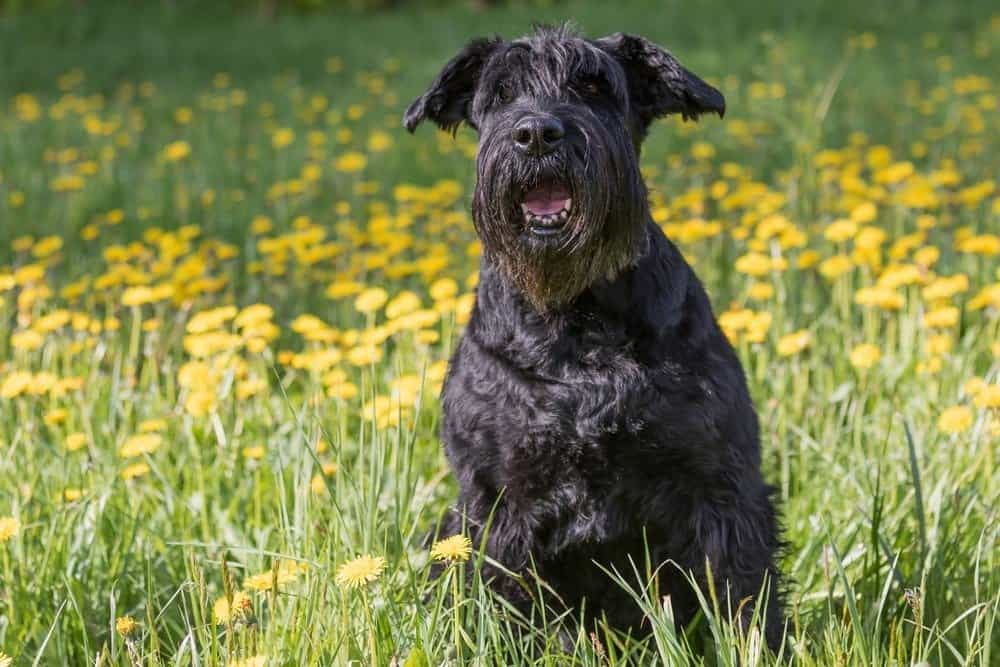
Giant schnauzers are intelligent dogs with herding instincts and a strong protective streak.
©Frank11/Shutterstock.com
10. Old English Sheepdog
Shaggy Old English sheepdogs are good-tempered dogs with a sweet outlook on life. They are fabulous family pets and love children, but they were originally bred in England to herd sheep! This means they are intelligent dogs with plenty of muscle and agility under the shaggy bear coat that protects them from the elements. Did you know their coats can be spun into yarn?
Old English sheepdogs stand up to 22 inches at the shoulder and walk with a rolling bear-like gait that makes them look ungainly. But don’t be fooled! This hard-working herder dog is agile enough for dog agility and clever enough to herd up the family if they think you’re not getting a move on or there’s danger nearby.

The Old English sheepdog was originally bred to herd sheep.
©DesignTop/Shutterstock.com
11. Puli
Puli dogs are better known as corded or braided dogs for their unmistakable naturally occurring corded coats.
They are a medium-sized, compact breed with powerful legs, endless stamina, and a herding instinct that’s strong enough to keep them working all day. Many people call puli dogs acrobats because they are so nimble on their feet, and this trait makes them excellent agility dogs.
Puli are poodle ancestors and bred in Hungary for their herding ability and weatherproof corded fur. On the ancient Hungarian plains, puli dogs herded the flock and raised the alarm if wolves should attack. In response, Komondor guard dogs would fight off the wild invaders!
Owners have reported their pet puli dogs herding sheep on walks even if they are purely a family pet.

Puli dogs have weatherproof corded coats.
©BORINA OLGA/Shutterstock.com
Sheep Dog Breeds: Different Dogs Used for Herding
There are many sheep dog breeds used for herding. Most make good family pets if owners are willing to train, exercise, and mentally stimulate their dogs.
Working dogs are bred for intelligence and stamina, so the majority need to live an active life. Different dogs used for herding become bored without plenty to do, which can lead to destructive behaviors.
The photo featured at the top of this post is © Ellis Berankova/Shutterstock.com
Ready to discover the top 10 cutest dog breeds in the entire world?
How about the fastest dogs, the largest dogs and those that are -- quite frankly -- just the kindest dogs on the planet? Each day, AZ Animals sends out lists just like this to our thousands of email subscribers. And the best part? It's FREE. Join today by entering your email below.
Thank you for reading! Have some feedback for us? Contact the AZ Animals editorial team.






